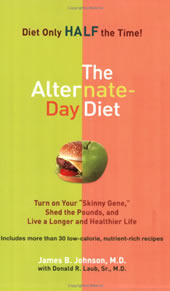Alternate Day Diet
 The Alternate-Day Diet: Turn on Your “Skinny Gene,” Shed the Pounds, and Live a Longer and Healthier Life was written by James B. Johnson, M.D.
The Alternate-Day Diet: Turn on Your “Skinny Gene,” Shed the Pounds, and Live a Longer and Healthier Life was written by James B. Johnson, M.D.
It achieves calorie restriction by severely limiting calories every second day so the result over time is a reduced calorie diet. This program is based on animal studies that indicate that restricting caloric intake on alternate days can turn on the “skinny” gene.
Dr. Johnson has applied the same theory in human clinical trials and discovered that not only does this approach promote weight loss, it also produces a whole range of beneficial effects on health. Volunteers lost on average eight per cent of their body weight over an eight-week period, and experienced benefits such as reduced inflammation, improved insulin resistance and better cellular energy production.
Johnson also claims that alternate day dieting can help to lower blood pressure, alleviate arthritis and reduce levels of potentially harmful free radicals in the bloodstream.
Alternate Day Diet Basics
Every day is either an Up Day or a Down Day. You are free to eat as much as you would like to on Up Days and On Down Days you will restrict calories. While you can eat whatever foods you want and as much as you like you should not intentionally overeat, but it is important that you eat enough so that you feel satisfied.
For the first two weeks of the diet you consume no more than 20% of your usual calorie intake on Down Days. To simplify matters a daily intake of 500 calories for Down Days is suggested during the induction phase.
Meal replacement shakes are recommended as the only food that you consume on the Down Days during the induction phase. This is because they are convenient and make it easy to monitor your calorie intake. You only have to diet for one day at a time. The next day is your Up Day where you are free to eat the way you normally would.
The longer-term Alternate Day Diet plan is not as restrictive as the first two weeks. You can eat real food on Down Days and can also increase your calorie intake to up to 35% of your normal amount if you want to lose weight. If you have already reached your target weight you will eat up to 60% of your normal calorie requirements in order to maintain your weight.
Recommended Foods
@Meal replacement shakes@, fruit, vegetables, chicken, turkey, fish, egg whites, pasta, oats, whole wheat bread, high-fiber cereal, legumes, kojac, Shirataki noodles, red wine.
Sample Diet Plan
| Breakfast
Veggie omelet |
| Lunch
Garbanzo bean spinach salad |
| Dinner Soft fish tacos |
Exercise Recommendations
Exercise is not necessary for The Alternate Day diet although general exercise information is included in the book.
Costs and Expenses
The Alternate-Day Diet: Turn on Your “Skinny Gene” , Shed the Pounds, and Live a Longer and Healthier Life retails at $14.95.
Pros
- No foods are completely off-limits.
- Easy to follow and stick to.
- Eliminates feelings of deprivation that occur with long-term dieting.
- Written by a medical doctor.
- Includes thirty days of Down Day menus.
- Includes fifty recipes.
- Studies suggest that this diet can significantly improve asthma.
- May improve metabolism and extend lifespan.
Cons
- Dieters may experience hunger and fatigue on down days.
- Not suitable for those with a history of eating disorders.
- Does not encourage exercise.
Not Suitable For Some
Some dieters may find the Alternate Day Diet program an easy way to reduce calories without being required to completely give up their normal diet. However, there is a potential for those who have a tendency towards disordered eating patterns, to overeat on the Up Days, which may negate the calorie restriction effects of this plan.
Additionally for many, the extremely low calorie intake on The Alternate Day Diet Down Days may result in hunger and fatigue that could potentially have a negative impact on the ability to perform normal daily activities.
- References:
- Wing, R. R., Blair, E. H., Bononi, P., Marcus, M. D., Watanabe, R., & Bergman, R. N. (1994). Caloric restriction per se is a significant factor in improvements in glycemic control and insulin sensitivity during weight loss in obese NIDDM patients. Diabetes care, 17(1), 30-36. link
- Weigle, D. S., Duell, P. B., Connor, W. E., Steiner, R. A., Soules, M. R., & Kuijper, J. L. (1997). Effect of Fasting, Refeeding, and Dietary Fat Restriction on Plasma Leptin Levels 1. The Journal of Clinical Endocrinology & Metabolism, 82(2), 561-565. link
- Wing, R. R., & Hill, J. O. (2001). Successful weight loss maintenance. Annual review of nutrition, 21(1), 323-341. link
Comments
Comments now closed